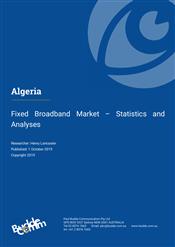Algeria - Fixed Broadband Market - Statistics and Analyses

Last updated: 1 Oct 2019 Update History
Report Status: Archived
Report Pages: 24
Analyst: Henry Lancaster
Synopsis
For many years the development of Algeria’s fixed-line broadband market was hampered by the limited reach of the fixed-line network. This created an environment which encouraged alternative operators to invest in fixed-wireless accesses.
The licensing of 3G spectrum to the three mobile network operators in late 2013 and the provision of LTE by all three MNOs since September 2016 has done much to ensure the availability of mobile internet access across the country. In addition, three telcos were awarded Universal Telecommunications Service (UTS) authorisations in early 2016 which allow them to provide wireless or fixed telecoms services to underserved areas. In common with other markets in the region, mobile connections account for the vast majority of internet accesses.
The government has also enabled operators (by the February 2017 Code of Posts and Electronic Communications) to access Algérie Télécom’s infrastructure through local loop unbundling, thus ending the incumbent’s effective monopoly on DSL-based services.
Improved international connectivity has substantially reduced the cost of broadband services in recent years. Algérie Télécom continues to invest to expand its national fibre infrastructure, while the government has committed funds towards its national broadband program despite declining revenue from the falling price of oil which has put pressure on its overall investments.
This report contains an overview of Algeria’s fixed and fixed-wireless broadband markets, providing key statistics, profiles of the major players, and subscriber forecast to 2024.
Key developments:
- ATS selects Hughes’s JUPITER System to provide satellite broadband services;
- Telemedicine network boosted by access to the services using the Alcomsat-1 satellite;
- New Post and Telecommunications Code launches LLU on Algérie Télécom’s fixed broadband infrastructure;
- Government pursues MSANs program to deliver broadband to towns with populations of between 1,000 and 2,000;
- Report update includes the regulator’s market data for 2018; telcos’ operating and financial data to Q2 2019; recent market developments.
Companies mentioned in this report:
Djaweb, EEPAD, Swan Informatique, IcosNet, Smart link Communication
Related Reports
- Africa - Fixed Broadband Market - Statistics and Analyses
- Algeria - Telecoms, Mobile and Broadband - Statistics and Analyses
- 2019 Africa - Mobile Network Operators and MVNOs
- Ethiopia - Telecoms, Mobile and Broadband - Statistics and Analyses
- Morocco - Telecoms, Mobile and Broadband - Statistics and Analyses
- Namibia - Telecoms, Mobile and Broadband - Statistics and Analyses
- Madagascar - Telecoms, Mobile and Broadband - Statistics and Analyses
- Benin - Telecoms, Mobile and Broadband - Statistics and Analyses
- Cameroon - Telecoms, Mobile and Broadband - Statistics and Analyses
- Eritrea - Telecoms, Mobile and Broadband - Statistics and Analyses
Share this Report
TMT Intelligence
A platform to scale your intelligence tasks
Monitor critical insights with our AI-powered Market Intelligence Platform gathering and analyzing intelligence in real time. With AI trained to spot emerging trends and detect new strategic opportunities, our clients use TMT Intelligence to accelerate their growth.
If you want to know more about it, please see:
Research Methodology
BuddeComm's strategic business reports contain a combination of both primary and secondary research statistics, analyses written by our senior analysts supported by a network of experts, industry contacts and researchers from around the world as well as our own scenario forecasts.
For more details, please see:
More than 4,000 customers from 140 countries utilise BuddeComm Research
Are you interested in BuddeComm's Custom Research Service?
Hot Topics
News & Views
Have the latest telecommunications industry news delivered to your inbox by subscribing to BuddeComm's weekly newsletter.